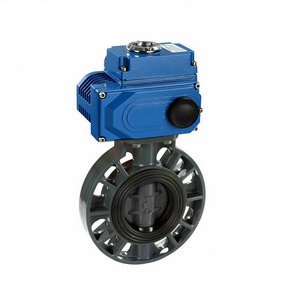Electric butterfly valve It is one of the most commonly used valve types in industrial valves, especially suitable for low-pressure large diameter applications. The butterfly plate of the butterfly valve is installed in the diameter direction of the pipeline. In the cylindrical channel of the butterfly valve body, the disc shaped butterfly plate rotates around the axis at an angle of 0°——90° Between, rotate to 90° The valve is fully open.
The butterfly valve is simple in structure, small in size and light in weight, and only consists of a few parts. And just rotate 90° The valve can be quickly opened and closed, and the operation is simple. At the same time, the valve has good fluid control characteristics. When the butterfly valve is in the fully open position, the thickness of the butterfly plate is the only resistance when the medium flows through the valve body, so the pressure drop generated by the valve is very small, so it has good flow control characteristics. Butterfly valve has two sealing types: elastic seal and metal seal. For elastic sealing valve, the sealing ring can be embedded on the valve body or attached to the periphery of the butterfly plate.
Different sealing surfaces of common butterfly valves can withstand different temperatures
General rubber sealing temperature can only withstand eighty The temperature of degrees. Another PTFE seal can withstand one hundred and eighty The temperature of H Seal can withstand four hundred and twenty-five The sealing surface code is W This valve can withstand different temperatures according to different materials. For example, the temperature of super duplex stainless steel can reach eight hundred degree
Metal sealed valves generally have longer service life than elastic sealed valves, but it is difficult to achieve complete sealing. The metal seal can adapt to higher working temperature, while the elastic seal has the defect of temperature limitation. If the butterfly valve is required to be used as flow control, the main thing is to correctly select the size and type of the valve. The structure principle of butterfly valve is particularly suitable for making large diameter valves. Butterfly valves are not only widely used in petroleum, gas, chemical, water treatment and other general industries, but also used in the cooling water system of thermal power stations.
The commonly used butterfly valves are wafer type butterfly valve and flange type butterfly valve. Wafer type butterfly valve uses stud bolts to connect the valve between two pipe flanges. Flange type butterfly valve has flanges on the valve, and bolts are used to connect the flanges on both ends of the valve to the pipe flanges. The strength performance of the valve refers to the ability of the valve to withstand the medium pressure. The valve is a mechanical product subject to internal pressure, so it must have sufficient strength and stiffness to ensure long-term use without cracking or deformation.

